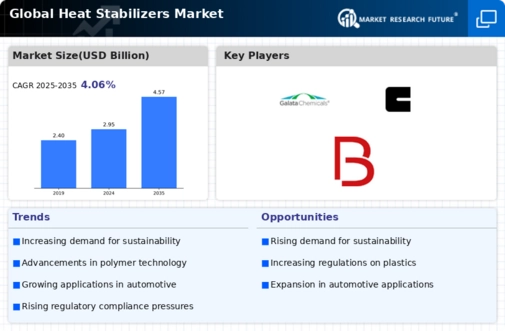Heat Stabilizers Size
Heat Stabilizers Market Growth Projections and Opportunities
The Heat Stabilizers market is influenced by various factors that shape its dynamics, growth, and competitiveness. Market forces play a pivotal role in determining the demand, supply, pricing, and innovation within this sector.
Supply and demand dynamics stand as the cornerstone of the Heat Stabilizers market. The demand for these stabilizers is largely contingent upon their applications across different industries such as construction, automotive, packaging, and others. Factors like urbanization, infrastructure development, and technological advancements in end-user industries significantly impact the demand for heat stabilizers.
Raw material prices and availability exert a notable influence on the Heat Stabilizers market. The primary materials used in heat stabilizers, such as metal compounds and organic acids, are subject to market fluctuations. The pricing and accessibility of these raw materials directly impact the overall production costs for heat stabilizers, thus affecting their market prices.
Government regulations and environmental policies also play a pivotal role in shaping the Heat Stabilizers market. Increasing focus on sustainability and environmental concerns has led to stringent regulations regarding the use of certain stabilizers, leading to a shift in consumer preferences and manufacturing practices towards eco-friendly alternatives. Compliance with these regulations often necessitates research and development efforts, thereby influencing the market landscape.
Technological advancements and innovations continually redefine the Heat Stabilizers market. Companies invest in R&D to develop advanced stabilizers that offer better performance, enhanced heat resistance, and environmental friendliness. Innovations in production processes also contribute to cost efficiency and quality improvement, further impacting market dynamics.
Global economic conditions and market trends significantly impact the Heat Stabilizers market. Economic fluctuations, trade policies, and geopolitical tensions can influence market growth, investment decisions, and consumer behavior. Moreover, emerging markets with increasing industrialization and infrastructural development contribute to the growth of the Heat Stabilizers market.
Competitive landscape and industry collaborations shape the market dynamics of Heat Stabilizers. Intense competition among key players drives innovation, pricing strategies, and market expansion efforts. Collaborations, mergers, and acquisitions within the industry often lead to the consolidation of market share, influencing market trends and dynamics.
Consumer preferences and awareness also play a vital role in shaping the Heat Stabilizers market. Growing awareness regarding the environmental impact of stabilizers has led to a shift in consumer preferences towards sustainable and eco-friendly products. As a result, manufacturers are increasingly focusing on developing and promoting greener alternatives to meet consumer demands.








Leave a Comment